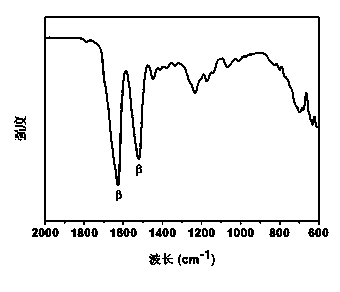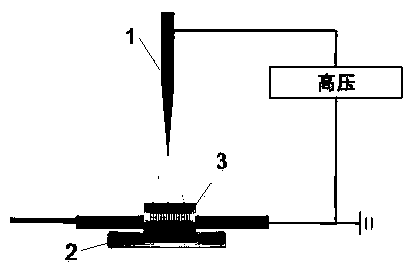Immediately crosslinking technology for preparing macroporous three-dimensional nanofiber bracket
A three-dimensional nano-fiber scaffold technology, applied in fiber processing, prosthesis, filament/wire forming, etc., can solve problems such as complex technology
- Summary
- Abstract
- Description
- Claims
- Application Information
AI Technical Summary
Problems solved by technology
Method used
Image
Examples
Embodiment 1
[0034] 1. Cut silkworm cocoons into 1cm 2 The small pieces were boiled with 500mL of 0.5% sodium carbonate solution for 1.5 hours, cleaned with deionized water, boiled in 500mL of deionized water for 0.5h, washed with deionized water and dried. Add about 60mL of calcium chloride / water / ethanol three-phase solution (the molar ratio of the three substances is 1 / 8 / 2) to the treated silk, stir in a water bath at 70°C for 1 hour to completely dissolve the silk, and then add the obtained The solution was dialyzed for 48 hours. After the dialysis, the solution was centrifuged at 8000r / min for 30 minutes and then filtered. The filtered solution was frozen in liquid nitrogen and then dried for 48 hours to obtain regenerated silk fibroin.
[0035] 2. Dissolve 2 g of regenerated silk fibroin in 8 g of a mixed solution of dichloromethane and trifluoroacetic acid at a mass ratio of 3:7 to prepare a solution for electrospinning with a mass fraction of regenerated silk fibroin of 20%.
[00...
Embodiment 2
[0042] 1. Cut silkworm cocoons into 1cm 2 The small pieces were boiled with 500mL of 0.5% sodium carbonate solution for 1.5 hours, cleaned with deionized water, boiled in 500mL of deionized water for 0.5h, washed with deionized water and dried. Add about 60mL of calcium chloride / water / ethanol three-phase solution (the molar ratio of the three substances is 1 / 8 / 2) to the treated silk, stir in a water bath at 70°C for 1 hour to completely dissolve the silk, and then add the obtained The solution was dialyzed for 48 hours. After the dialysis, the solution was centrifuged at 8000r / min for 30 minutes and then filtered. The filtered solution was frozen in liquid nitrogen and then dried for 48 hours to obtain regenerated silk fibroin.
[0043] 2. Mix and dissolve 0.5g of regenerated silk fibroin and 0.5g of chitosan in 9g of a mixed solution of dichloromethane and trifluoroacetic acid with a mass ratio of 3:7 to prepare a mixture for electrospinning with a mass fraction of 10%. sol...
Embodiment 3
[0050] 1. Cut silkworm cocoons into 1cm 2 The small pieces were boiled with 500mL of 0.5% sodium carbonate solution for 1.5 hours, cleaned with deionized water, boiled in 500mL of deionized water for 0.5h, washed with deionized water and dried. Add about 60mL of calcium chloride / water / ethanol three-phase solution (the molar ratio of the three substances is 1 / 8 / 2) to the treated silk, stir in a water bath at 70°C for 1 hour to completely dissolve the silk, and then add the obtained The solution was dialyzed for 48 hours. After the dialysis, the solution was centrifuged at 8000r / min for 30 minutes and then filtered. The filtered solution was frozen in liquid nitrogen and then dried for 48 hours to obtain regenerated silk fibroin.
[0051] 2. Mix and dissolve 0.75g of regenerated silk fibroin and 0.25g of chitosan in 9g of a mixed solution of dichloromethane and trifluoroacetic acid at a mass ratio of 3:7 to prepare a mixture for electrospinning with a mass fraction of 10%. sol...
PUM
| Property | Measurement | Unit |
|---|---|---|
| Diameter | aaaaa | aaaaa |
Abstract
Description
Claims
Application Information
 Login to View More
Login to View More - R&D
- Intellectual Property
- Life Sciences
- Materials
- Tech Scout
- Unparalleled Data Quality
- Higher Quality Content
- 60% Fewer Hallucinations
Browse by: Latest US Patents, China's latest patents, Technical Efficacy Thesaurus, Application Domain, Technology Topic, Popular Technical Reports.
© 2025 PatSnap. All rights reserved.Legal|Privacy policy|Modern Slavery Act Transparency Statement|Sitemap|About US| Contact US: help@patsnap.com



